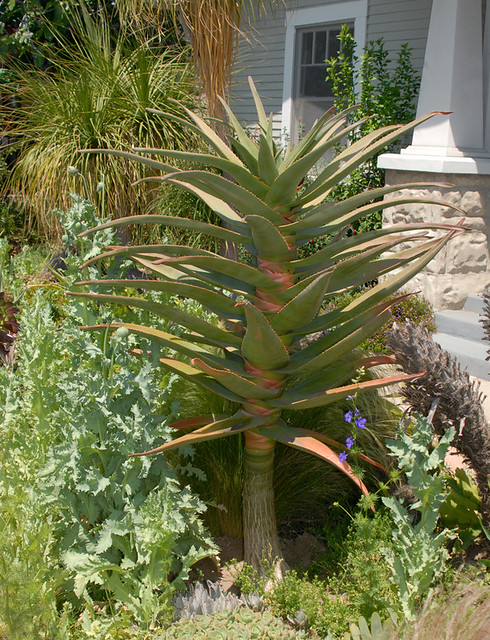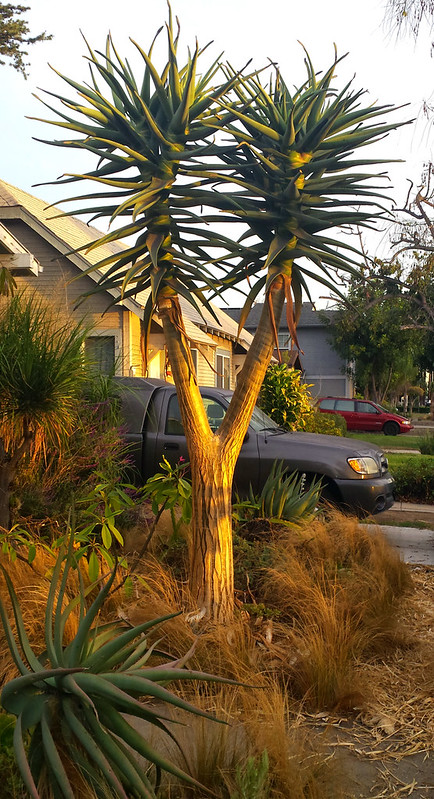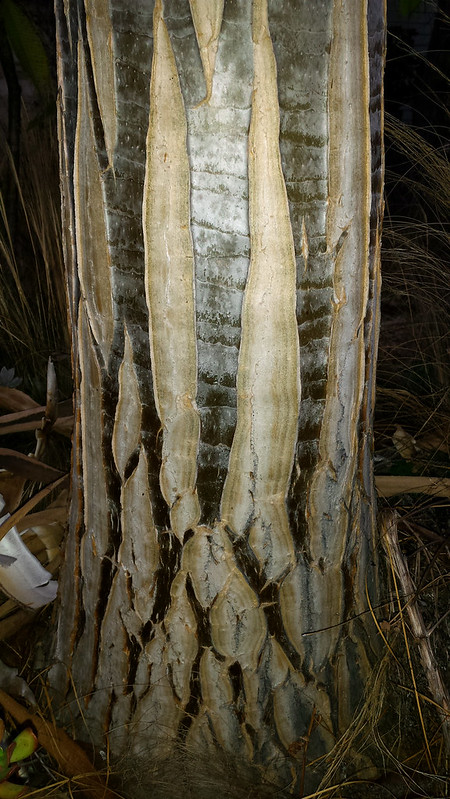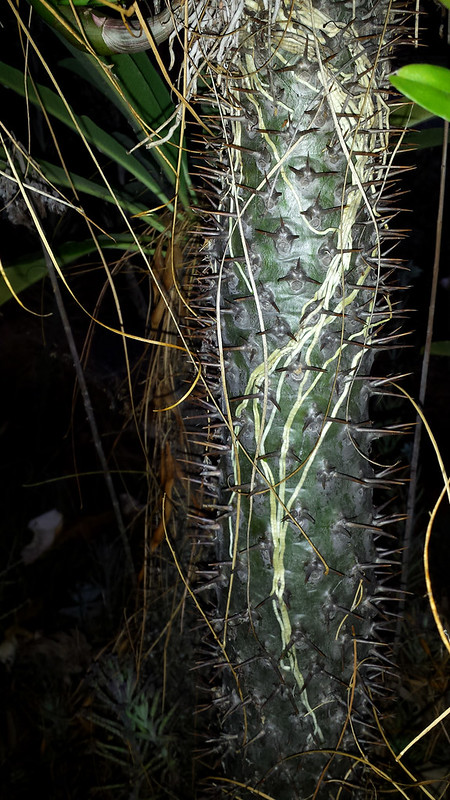
Here's the same guy less than 5 years later...

Hercules has tripled in size! For a tree Aloe that's super fast! The tree Aloe in the foreground... Aloe speciosa...and the tree Aloe in the background...Aloe ferox...have been in the ground for around the same time but they still look like bush Aloes.
Maybe you're wondering if Hercules is "juicing"? Not that I know of. I've certainly never given him any Miracle Grow or any other type of fertilizer. And during summer I water the front yard infrequently at best and the rest of the year it's entirely dependent on rain. Hercules really doesn't get any special treatment. Well...I do introduce him to pretty much anybody and everybody...friends, the mailman, the neighbors, Jehovah's Witnesses. Maybe he thrives on attention?
My guess is that the secret to Hercules' speed is that, unlike all my other Aloes, he doesn't take a break. This is because his parents are Aloe barberae and Aloe dichotoma.
Aloe barberae is from southeast Africa where it rains when its warm. Aloe dichotoma is from southwest Africa where it rains when its cool. This means that Hercules happily grows in a wide range of temps.
But maybe I should engage in some due diligence. These two studies (one, two) listed some weather stations located within the distribution range of Aloe dichotoma. I used the info to create this table...
| Station | Rain Type |
Yearly Rainfall
(mm / inches)
|
|
| Luderitz, Namibia | Warm | 41.4 | 1.63 |
| Alexander Bay, South Africa | Warm | 48.1 | 1.9 |
| Port Nolloth, South Africa | Warm | 69 | 2.72 |
| Grunau, Namibia | Warm | 72 | 2.83 |
| Sitrusdal, South Africa | CI | 120 | 4.72 |
| Calvinia, South Africa | CI | 147 | 5.79 |
| Keetmanshoop, Namibia | Warm | 184.5 | 7.26 |
| Okiep, South Africa | CIW | 226.6 | 8.92 |
| Upington, South Africa | Warm | 250.5 | 9.86 |
| Remhoogte, South Africa | CIW | 254.9 | 10.04 |
| Okaukuejo, Namibia | Warm | 291 | 11.46 |
| Prieska, South Africa | Warm | 318 | 12.51 |
| Windhoek, Namibia | Warm | 353.1 | 13.9 |
| Spitzkop, South Africa | CIW | 411 | 16.18 |
| Brandvlei, South Africa | Warm | 817.1 | 32.17 |
The data strikes me as kinda iffy though. Perhaps somebody can double check it.
The general idea is that plants grow when they receive sufficient rain. If the rain falls primarily when its cool...then this is when the plants in that area will grow. Or, if the rain falls primarily when its warm...then this is when the plants in that area will grow. It seems, based on the data from the weather stations, that most Aloe dichotomas occur in areas where it mainly rains when its warm. Therefore most of them are warm growers. But there are certainly some exceptions.
The question is...was Hercules' dichotoma parent an exception? I'd guess so given that my Hercules grows year around here in Southern California.
Hercules' stellar performance has created a bit of an issue though. It's the opposite of a silver lining...whatever that is. Out of the gazillion plants that I grow...Hercules is the only one that grows year around. Everybody else takes a winter break...except for a few, like the Aeoniums, that take a summer break. Before Hercules it seemed perfectly acceptable for plants to take a break. Now, after Hercules, it seems like these "breakers" have a terrible grow ethic. Hercules has ruined the curve! He's raised the bar super high! He's making all my other plants look like slackers and underachievers.
This jarring juxtapose motivated me to post a thread in the PalmTalk forum a couple years ago ... Summer Rain / Winter Rain Crosses? In that thread I listed a few other possible winter rain x summer rain crosses. I also wondered whether year around growers could be created simply by crossing cool growers and warm growers. Now it seems somewhat obvious. I think. But then...why aren't there more cool x warm hybrids?
Maybe it's because there doesn't seem to be a word for a plant that grows in a wide range of temperatures. I think the closest word is "eurythermal". It refers to an organism that tolerates a wide range of temperatures. But as Hercules has conclusively demonstrated... there's a huge difference between tolerating and growing. So I took the liberty of coining a new term... "hercutherm". It refers to a plant that grows in a wide range of temperatures. There's always room for improvement though so any wordsmiths out there are more than welcome to come up with a better term.
Another possible explanation is that there isn't enough demand. Mediterranean climates are certainly the exception rather than the rule. Maybe there just aren't enough people interested in hercutherms? Hmmm... if only there was some way to measure demand. Oh wait! There is!
HybridizeThis
That's a new group on Reddit that gives people the opportunity to submit and vote on hybrid requests. In theory, if the "demand" for a hybrid is high enough...then maybe hybridizers will supply it. I put "demand" in quotes because willingness to vote doesn't necessarily equate to willingness to pay. But some information regarding demand is better than no information.
Another possible explanation is that there isn't enough demand. Mediterranean climates are certainly the exception rather than the rule. Maybe there just aren't enough people interested in hercutherms? Hmmm... if only there was some way to measure demand. Oh wait! There is!
HybridizeThis
That's a new group on Reddit that gives people the opportunity to submit and vote on hybrid requests. In theory, if the "demand" for a hybrid is high enough...then maybe hybridizers will supply it. I put "demand" in quotes because willingness to vote doesn't necessarily equate to willingness to pay. But some information regarding demand is better than no information.
While on the topic of hybrids...let's see if we can't get a good glimpse of the big picture. I recently ran across this article... The Truth About White Tigers and Why Their Breeding Needs to Stop...
For example, zoo animals in the U.K. were deemed to be “genetic disasters” by conservation geneticist Dr. Paul O’Donoghue back in December. O’Donoghue stated that the pedigrees of many zoo animals had become contaminated by hybridization with different but related species, “sharing more DNA than if they were cousins … it is clear that people who visit zoos to see iconic animals are often looking at hybrids which have zero conservation value.”Zero conservation value...those specific hybrids or hybrids in general? Is it possible for any hybrids to have any conservation value? I'm pretty sure that the answer is yes. Why? Because a hybrid can help us hedge our bets against changing conditions.
Most of you are familiar with the story of Goldilocks and the Three Bears. But just in case...
There's this strange little blond girl who breaks into a random house. Once inside she finds three bowls of oatmeal on a table. She tries the first bowl...which is too hot. The second bowl is too cold...but the third bowl is just right. After she eats the oatmeal she decides to watch TV. There are three chairs to choose from. The first chair is too large, the second is too small but the third is just right. Pretty soon Goldilocks becomes sleepy so she decides to take a nap. She goes upstairs and finds a bed...which is too hard. She finds another bed...which is too soft. The third bed she finds is just right.
The moral of the story is, for our intents and purposes, that it's entirely possible that mother nature might decide that any given hybrid has intermediate traits that are "just right" for any given niche. To be fair, it's kind of hard to imagine a situation in which mother nature would decide that a poodle is "just right" for a natural niche. So perhaps the potential conservation value of any given hybrid depends on whether the focus was human nature and/or mother nature.
You like an orchid hybrid? Great! But what about mother nature? Would she decide that it's "just right" for any niche?
I really get the feeling that there isn't a single conservationist, biologist or ecologist out there that would approve of introducing orchid hybrids to nature. And maybe they are correct. But I'd sure like to hear their arguments. Is it likely that mother nature will choose a hybrid that isn't "just right"? If mother nature's judgement is so impaired, then what are the chances that any species is "just right"?
Any economist worth his salt would tell you that the big picture is a robust hedge. Just because Goldilocks has decided that oatmeal C is "just right" for today doesn't mean she'll decide that it's "just right" for tomorrow. Maybe Goldilocks will decide that oatmeal C is too sweet. Then what? Will there be an oatmeal D for her to choose?
The moral of the story is, for our intents and purposes, that it's entirely possible that mother nature might decide that any given hybrid has intermediate traits that are "just right" for any given niche. To be fair, it's kind of hard to imagine a situation in which mother nature would decide that a poodle is "just right" for a natural niche. So perhaps the potential conservation value of any given hybrid depends on whether the focus was human nature and/or mother nature.
You like an orchid hybrid? Great! But what about mother nature? Would she decide that it's "just right" for any niche?
I really get the feeling that there isn't a single conservationist, biologist or ecologist out there that would approve of introducing orchid hybrids to nature. And maybe they are correct. But I'd sure like to hear their arguments. Is it likely that mother nature will choose a hybrid that isn't "just right"? If mother nature's judgement is so impaired, then what are the chances that any species is "just right"?
Any economist worth his salt would tell you that the big picture is a robust hedge. Just because Goldilocks has decided that oatmeal C is "just right" for today doesn't mean she'll decide that it's "just right" for tomorrow. Maybe Goldilocks will decide that oatmeal C is too sweet. Then what? Will there be an oatmeal D for her to choose?
The greater the quantity of marginally different options we offer to mother nature... the greater the chances that the future will have the maximum possible diversity. Orchids understand this. They offer mother nature a huge range of options to choose from. A single seed pod can contain a million seeds that all have a unique combination of traits. This robust hedge increases the chances that mother nature will decide that one of the seeds is "just right" for a certain niche.
Speaking of seeds, the main reason I took the second photo of Hercules was because I had just noticed that he was developing his very first spike. It's kind of funny because here's what I posted just a few months ago in this XericWorld thread... Son of Hercules...Samson?
It would be really awesome if some seed pods develop. Perhaps Goldilocks would decide that one of the seedlings was even more "just right" for Glendale, CA than my Hercules? That would be crazy cool! But based on the accounts in the thread it seems like pollination is iffy. Chemnick only had one seed pod on his Hercules and Coniff didn't have any luck after attempting numerous crosses. I wonder how many other Aloes they had in bloom at the same time as their Hercules?
Right now I only have two other tree Aloes that should be in flower at the same time as Hercules...Aloe arborescens variegata and an Aloe that I think might be nyeriensis. So it's really not much of a hedge. I also had a regular arborescens in spike but I decided to remove it. I'd be surprised if Hercules was compatible with one but not the other and I'd definitely prefer to increase the chances of the seedlings being variegated. But maybe I'll hit up my friend Alfred or the Huntington for some pollen.
Speaking of seeds, the main reason I took the second photo of Hercules was because I had just noticed that he was developing his very first spike. It's kind of funny because here's what I posted just a few months ago in this XericWorld thread... Son of Hercules...Samson?
Outstanding seedlings!
How long does it take Hercules to bloom? The top of mine is quickly approaching the height of my tallest ladder. If it doesn't bloom within the next couple years I'm going to have to use a pruning pole to try and cut down any future seed pods. I try to avoid watering it but I get the feeling that its roots have traveled all over the front yard.
Does it matter if it's a clone? I've had A. barberae and A. dichotoma for pretty much the same time and they haven't bloomed either. My Aloe tongaensis 'Medusa', on the other hand, bloomed when it was around 2' tall. Anybody crossed dichotoma with tongaensis?I guess Hercules must have read what I wrote.
It would be really awesome if some seed pods develop. Perhaps Goldilocks would decide that one of the seedlings was even more "just right" for Glendale, CA than my Hercules? That would be crazy cool! But based on the accounts in the thread it seems like pollination is iffy. Chemnick only had one seed pod on his Hercules and Coniff didn't have any luck after attempting numerous crosses. I wonder how many other Aloes they had in bloom at the same time as their Hercules?
Right now I only have two other tree Aloes that should be in flower at the same time as Hercules...Aloe arborescens variegata and an Aloe that I think might be nyeriensis. So it's really not much of a hedge. I also had a regular arborescens in spike but I decided to remove it. I'd be surprised if Hercules was compatible with one but not the other and I'd definitely prefer to increase the chances of the seedlings being variegated. But maybe I'll hit up my friend Alfred or the Huntington for some pollen.
A while back I contemplated walking around the neighborhood and leaving a compot of Aloe thraskii seedlings on people's porches... Green Thumbprint. I have two flats worth. It would make walking around the neighborhood that much more enjoyable if I could compare the seedlings' progress and variation. Assuming of course that some were planted in front yards. The problem is that I don't necessarily want to prompt greater interaction with neighbors. Occasional interaction with one or two is ok. But anymore than that wouldn't be my cup of tea. Well...unless the interactions were strictly plant related. The more plant friends the better!
With Hercules in spike though...I'm honestly considering tempting fate by promising mother nature that I'd disseminate any extra seedlings around the neighborhood. And by extra I mean any that weren't variegated or promised to members of the Epiphyte Society of Southern California.
This reminds me of this opportunity cost passage....
‘Hercules, (says she,) I offer myself to you, because I know you are descended from the gods, and give proofs of that descent by your love to virtue, and application to the studies proper for your age. This makes me hope you will gain, both for yourself and me, an immortal reputation. But before I invite you into my society and friendship, I will be open and sincere with you, and must lay down this as an established truth, that there is nothing truly valuable which can be purchased without pains and labour. The gods have set a price upon every real and noble pleasure. If you would gain the favour of the deity, you must be at the pains of worshiping him; if the friendship of good men, you must study to oblige them; if you would be honoured by your country, you must take care to serve it. In short, if you would be eminent in war or peace, you must become master of all the qualifications that can make you so. These are the only terms and conditions upon which I can propose happiness.’ - Joseph Addison
So should I tempt fate? Then again, I'm not too sure how many of my neighbors would want Hercules growing in their yards.
If you look at the second photo of Hercules again you might notice that something is missing. No, I'm not referring to the messy yard missing lots of tidying. That's exactly how Tiger, the neighborhood stray tomcat, wants the yard to be. And no, I'm not referring to a bird's nest. Some crazy mockingbird family had the audacity to build a nest on Hercules. The birds would dive bomb anybody who walked past...especially Tiger. But Hercules pretty quickly shrugged the nest off.
Hopefully some of you guessed that the correct answer is an orchid! Yes, Hercules is missing an orchid. He's completely naked. It's terribly indecent. I should really do something about it! The problem is that it's not the easiest thing to figure out which orchid is worthy of adorning Hercules. And perhaps such an orchid doesn't even exist! *gasp*
Unlike with Aloes, there aren't any epiphytic orchids in Mediterranean climates so a winter rain x summer rain cross wouldn't be possible. But...there are plenty of warm growing epiphytic orchids that could be crossed with cool growing epiphytic orchids. Unfortunately, my experience with cool growers is very limited. During winter I reduce watering quite a bit so this hinders their ability to grow when it's cool. As I mentioned in this blog entry... Substantive vs Superficial Selection... how early in the year an orchid initiates its growth is the best indication I have regarding how cool growing it might be.
Thanks to the Orchid Culture website though...it's easy enough to evaluate a hypothetical hercuthermal hybrid. For example, Sarcochilus hillii is a warm growing monopodial orchid from southeast Australia and Drymoanthus adversus is a cool growing monopodial orchid from New Zealand. They are probably compatible so crossing them (Sarcoanthus?) could potentially produce a hercuthermal orchid.
Here are some ombrothermic diagrams I created based on the climate info...
Unlike with Aloes, there aren't any epiphytic orchids in Mediterranean climates so a winter rain x summer rain cross wouldn't be possible. But...there are plenty of warm growing epiphytic orchids that could be crossed with cool growing epiphytic orchids. Unfortunately, my experience with cool growers is very limited. During winter I reduce watering quite a bit so this hinders their ability to grow when it's cool. As I mentioned in this blog entry... Substantive vs Superficial Selection... how early in the year an orchid initiates its growth is the best indication I have regarding how cool growing it might be.
Thanks to the Orchid Culture website though...it's easy enough to evaluate a hypothetical hercuthermal hybrid. For example, Sarcochilus hillii is a warm growing monopodial orchid from southeast Australia and Drymoanthus adversus is a cool growing monopodial orchid from New Zealand. They are probably compatible so crossing them (Sarcoanthus?) could potentially produce a hercuthermal orchid.
Here are some ombrothermic diagrams I created based on the climate info...
The brown line represents the average high temp, the green line represents the average low temp and the blue line represents precipitation. The scale on the left is for temperature (Fahrenheit) and the scale on the right is for rain (inches).
As you can see, Sarcochilus hillii receives most of its water during summer...when it's warm. So it's probably a warm grower that has no problem tolerating cooler temperatures. Drymoanthus adversus, on the other hand, probably grows year around because there isn't a significant reduction in water. But would D. adversus grow year around here in Los Angeles? Maybe not during summer. Our summer heat might be outside its temperature grow range (TGR).
San Francisco would be more "just right" for D. adversus...
San Francisco would be more "just right" for D. adversus...
And Eureka would be even more "just right" than San Francisco...
What about Sarcoanthus though? Would it be more "just right" for Los Angeles than both its parents? Let's think about it. If the pollination was successful then we'd have a seed pod with maybe a million seeds inside. Each seed would have an entirely unique combination of traits. If every single seed germinated then perhaps each one would have a unique TGR.
Imagine if there was some way to determine each seedlings' perfect TGR. Maybe we could simply ask each one?
"Hey little dude, here's a map of California...where would you prefer to grow?"
What would the distribution of their preferences look like? Maybe something like this...
Then you'd get in your car with a million seedlings, drive up the coast and drop each one off at their preferred location. Well...you'd have to try and find somebody in the area willing to adopt them...because they would need some supplemental water.
With so many seedlings the chances are pretty good that more than a few of them would happily grow year around here in Southern California.
But would a hercuthermal Sarcoanthus be worthy of adorning Hercules? Perhaps a Cattleya alliance hercutherm would be a better match?
The most well known Cattleya alliance cool grower is the striking Encyclia vitellina. We could cross it with the warm growing Brassavola subulifolia in order to try and create a hercuthermal orchid. Let's take a look at the diagrams...
The Brassavola's TGR matches LA's summer temps and the Encyclia's TGR matches LA's winter temps. It looks very possible that a hybrid made from the two species could grow year around here in Los Angeles. And unlike the previous example...this hybrid (or close enough) has already been made...
Brassavola cordata x Encyclia vitellina
There were quite a few bids! I know for a fact that the winner of the auction is interested in hercuthermal orchids. No, it wasn't me...it was a friend of mine who lives in the area. Hopefully he'll be able to share some first hand experience as to whether or not the hybrid grows year around here in Southern California. But it's a pretty good sign that, according to the vendor, this hybrid is "a very vigorous plant and can flower multiple times per year under good cultural conditions".
While we're at it...we might as well take a look at a Dendrobium example using two species from Australia... Dendrobium rex and Dendrobium falcorostrum.
Would you be surprised if the hybrid was hercuthermal? I wouldn't be.
This monster Antelope Dendrobium hybrid definitely isn't very hercuthermal...but what if it was? Could you imagine it growing year around on Hercules?
For some people it would be a travesty to attach an orchid to Hercules' beautiful trunk. A while back over on GardenWeb I posted a thread about phorobanas in the bonsai forum. It only received one reply. According to the person who replied, I was "covering up the best part".
Here's a photo of Hercules' trunk...

To help you imagine what it might look like with an orchid growing on it...here's a photo of an Antelope Dendrobium hybrid (discolor x canaliculatum) growing on my Pachypodium lamerei...

From my perspective, orchid roots are the equivalent of a pearl necklace. They don't cover the best part...they accentuate it. They give your eyes an excuse to linger longer. Hmmm....and now I want to attach an orchid to a mannequin! Dave's got a mannequin! What are they made of anyways? Perhaps a statue would be a better choice...

How great would some orchid roots look on those statues? The Getty probably wouldn't mind if I attached some orchids to them...right? Not sure how they'd get watered though.
Since I'm already in left field anyways...imagine an orchid growing 10 feet high on a tree in a public garden. What if the orchid had a sign that said "water me" and a water gun and a drinking fountain next to the tree? How much water would the orchid get? Too much? Too little? Enough to survive? Would it help if the sign said, "water me if I look dry"? How many people would be able to correctly identify what a thirsty orchid looks like? This arrangement would be a conceptual, interactive, educational, experimental and living art installation. Probably a bit too cutting edge for the Getty. I could be wrong though. I'll let you know if they give me a call.
Tonight I'm going to dream about every pedestrian in Los Angeles carrying a water gun and squirting orchids attached to street trees. And now, everybody walks in LA.
Out of curiosity I googled "Aloe Hercules blog" and found another fan....Hercules in a Piece of Eden.
So...have I covered enough territory? I hope that you will all utilize the HybridizeThis group on Reddit to share your interest in hybrids that should be more abundant.

No comments:
Post a Comment